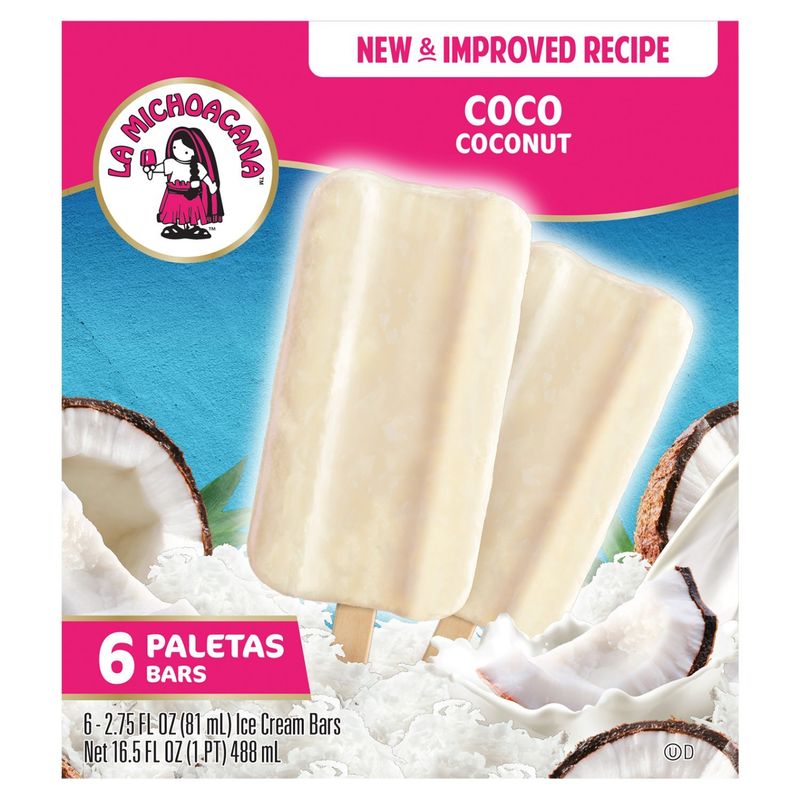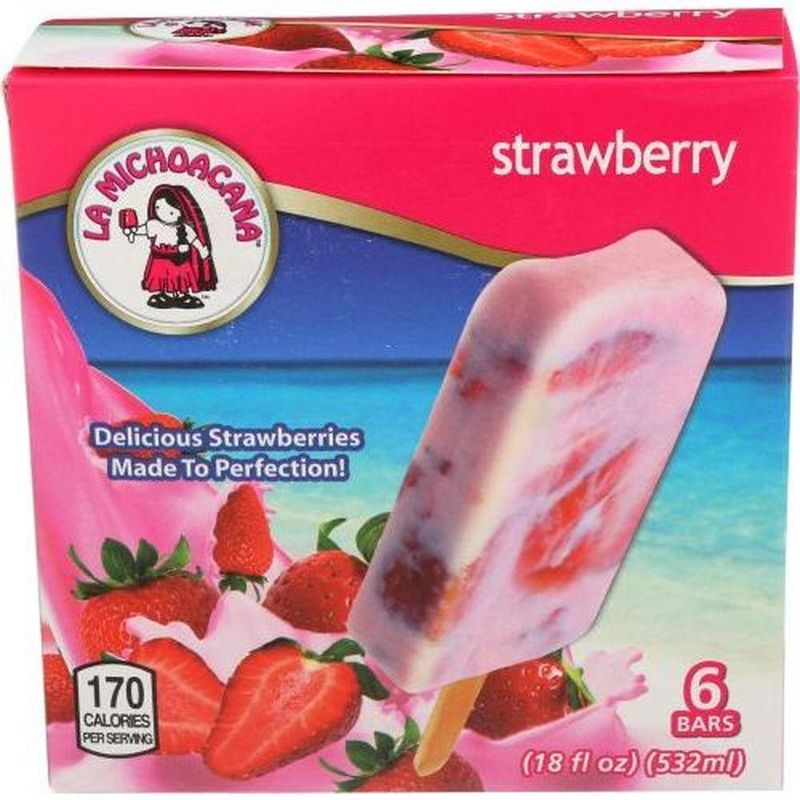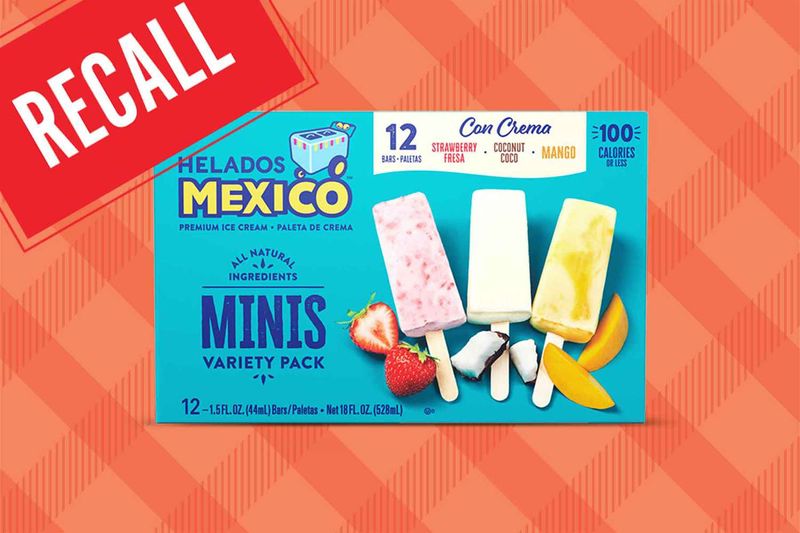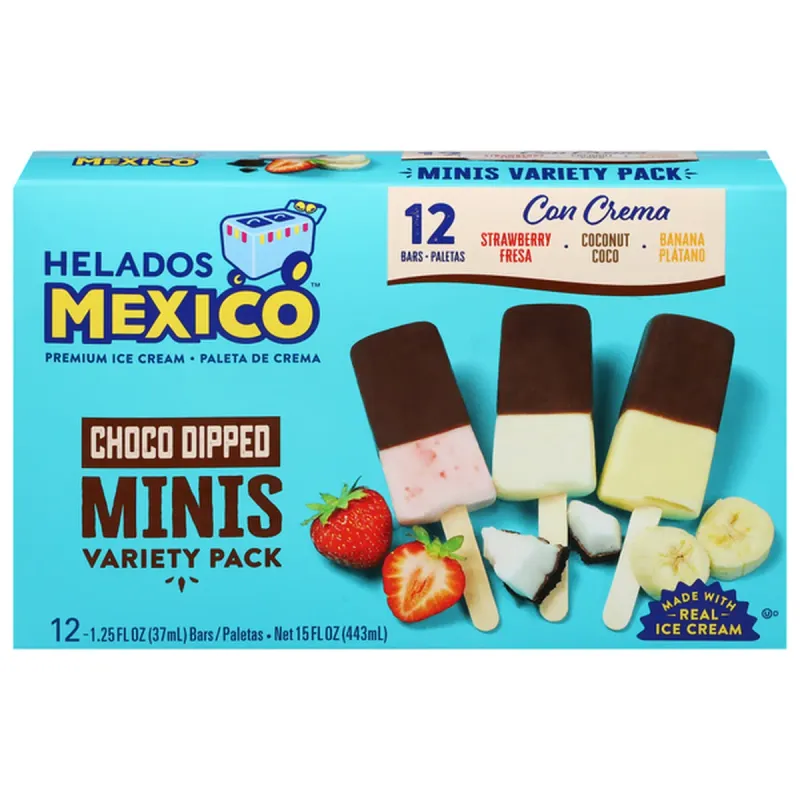A serious food safety alert has frozen families in their tracks as health officials announce a major recall affecting popular ice cream brands. Multiple products from La Michoacana and Helados Mexico contain undeclared milk, creating dangerous conditions for people with dairy allergies. Anyone with milk sensitivities could face life-threatening reactions from these mislabeled frozen treats. Checking your freezer right now could prevent a medical emergency for you or your loved ones.

1. LaMichoacana Coconut Singles: A Tropical Treat Turned Threat
LaMichoacana coconut singles with best-by dates ranging from October 3, 2026, to May 3, 2027, have become the center of a serious food safety concern. These individually wrapped frozen treats were supposed to offer a refreshing tropical escape but instead pose significant health risks to unsuspecting consumers.
The coconut flavor typically attracts people seeking dairy-free alternatives, making this recall particularly troubling. Many consumers with milk allergies specifically choose coconut-based products believing they’re safe options. Unfortunately, manufacturing errors have introduced undeclared milk proteins into these supposedly dairy-free treats.
Parents who purchased these items for lactose-intolerant children face especially concerning situations. Schools and daycare centers that stock these products must immediately check their freezers. The wide date range indicates this problem affected multiple production batches over several months.

Food manufacturers have strict labeling requirements precisely because allergic reactions can escalate quickly. Even trace amounts of milk protein can trigger severe responses in sensitive individuals. Symptoms might include hives, swelling, difficulty breathing, or dangerous drops in blood pressure.
If you discover these coconut singles in your freezer, resist the temptation to taste-test them first. Instead, immediately dispose of the products or return them to your purchase location for a full refund. Contact your doctor if anyone in your household has already consumed these items and experienced unusual symptoms.
This recall demonstrates why reading expiration dates and staying informed about food safety alerts protects your family’s health. Always verify product information through official FDA channels when recalls are announced.
2. LaMichoacana Strawberry Singles: Sweet Danger in Pink Packaging
Strawberry-flavored frozen treats usually represent childhood joy and summer memories, but certain LaMichoacana strawberry singles have become sources of serious health concerns. Products bearing best-by dates from October 1, 2026, through May 16, 2027, contain undeclared milk ingredients that weren’t listed on their colorful packaging. This oversight transforms innocent-looking pink popsicles into potential medical emergencies for dairy-sensitive consumers.
The strawberry variety often appeals to children, making this recall particularly heart-wrenching for parents. Many families choose fruit-flavored frozen treats assuming they’re safer than obviously creamy options. However, cross-contamination during manufacturing processes can introduce allergens into seemingly innocent products.
Retail locations nationwide carried these affected strawberry singles, spreading the contamination risk across multiple states and communities. Corner stores, supermarkets, and specialty food shops all potentially stocked these problematic items. The extended best-by date range suggests widespread distribution occurred before the contamination was discovered.

Allergic reactions to hidden milk proteins can develop within minutes of consumption. Early warning signs include tingling sensations around the mouth, stomach cramping, or skin irritation. More severe reactions might involve respiratory distress, rapid pulse, or loss of consciousness requiring immediate emergency medical attention.
Consumers should immediately examine any LaMichoacana strawberry products currently stored in their freezers. Don’t rely on visual inspection alone – check the specific best-by dates printed on individual packaging. Even if the product looks normal, the hidden milk contamination remains invisible to casual observation.
This situation reinforces the importance of maintaining updated emergency action plans for family members with known food allergies. Keep antihistamines and epinephrine auto-injectors readily accessible, and ensure all household members understand proper usage procedures.
3. LaMichoacana Bubble Gum Singles: Childhood Fun Meets Safety Concerns
Bubble gum-flavored popsicles typically evoke memories of carefree childhood days, but specific LaMichoacana bubble gum singles have transformed into serious health hazards. Items with best-by dates spanning April 7, 2027, to April 19, 2027, contain dangerous undeclared milk ingredients that could trigger severe allergic reactions. This narrow date range suggests a concentrated production period when contamination occurred, affecting a specific batch of these playfully colored frozen treats.
The bubble gum flavor particularly attracts young consumers who might not understand the severity of food allergies. Bright packaging and fun flavors can mask serious safety issues lurking beneath the surface. Parents must remain vigilant about checking product labels and staying informed about recall announcements affecting their children’s favorite treats.
Manufacturing facilities often produce multiple product lines using shared equipment, creating opportunities for cross-contamination. Even thorough cleaning procedures sometimes fail to eliminate all traces of allergenic ingredients from production machinery. Quality control systems are designed to catch these problems, but occasionally dangerous products slip through safety nets.
The relatively short timeframe between best-by dates indicates this contamination likely occurred during a specific production run. This information helps consumers identify potentially dangerous products more precisely. However, the concentrated timing also means many affected items might still be circulating in retail locations and home freezers.
Children experiencing allergic reactions might not immediately recognize or communicate their symptoms effectively. Watch for behavioral changes, complaints about mouth tingling, or signs of digestive distress after consuming frozen treats. Young people might describe symptoms as “feeling funny” or having a “weird taste” in their mouths.
Educational opportunities arise from recall situations like this one. Teach children about reading food labels, recognizing allergy symptoms, and understanding why certain foods might be dangerous for some people. These lessons could prevent future emergencies and develop lifelong safety awareness.
4. LaMichoacana Cookies and Cream Singles: Irony in Frozen Form
Nothing seems more ironic than a cookies and cream flavored product being recalled for undeclared milk, yet that’s exactly what happened with certain LaMichoacana singles. Products bearing best-by dates from April 9, 2027, to April 11, 2027, contain milk ingredients that weren’t properly disclosed on packaging labels. This three-day window represents one of the narrowest recall ranges, suggesting a very specific production problem during that timeframe.
Cookies and cream flavors typically contain obvious dairy ingredients, making this recall somewhat puzzling for consumers. However, the issue lies not in the expected presence of milk, but in the failure to properly declare it on ingredient lists. People with severe milk allergies rely completely on accurate labeling to make safe food choices.
The compressed timeline of affected products indicates a concentrated manufacturing issue. Quality control systems should have caught labeling errors before products reached retail shelves. Unfortunately, human oversight and mechanical failures sometimes allow dangerous items to enter the food supply chain.
Consumers who purchased these products during the specific date range face immediate health risks if allergic reactions occur. Even people who regularly consume dairy might experience problems if they’ve developed new sensitivities. Adult-onset food allergies are increasingly common and can appear without warning.
Proper disposal of recalled products requires more than simply throwing them in regular trash. Wrap items securely to prevent accidental consumption by family members or pets. Some communities offer special disposal programs for recalled food items to ensure they don’t accidentally re-enter the food supply.
This recall highlights the critical importance of manufacturing transparency and accurate ingredient disclosure. Food producers bear legal and moral responsibilities to protect consumers through honest labeling practices. When these systems fail, vulnerable populations face potentially life-threatening consequences from seemingly innocent mistakes.
5. LaMichoacana Mango Singles: Tropical Dreams Become Nightmares
Mango-flavored frozen treats promise exotic sweetness and tropical satisfaction, but certain LaMichoacana mango singles have become sources of unexpected danger. Products with best-by dates ranging from February 3, 2027, to April 8, 2027, contain undeclared milk ingredients that transform these sunny-colored popsicles into potential medical emergencies. The extended date range suggests this contamination problem persisted across multiple production cycles.
Fruit-flavored frozen desserts typically attract health-conscious consumers seeking lighter alternatives to obviously creamy products. Many people with dairy allergies specifically choose mango and other tropical flavors believing they represent safer options. This recall shatters those assumptions and demonstrates how contamination can occur in unexpected places.
The mango variety often appeals to diverse cultural communities where this fruit holds special significance. Hispanic families, in particular, might have purchased these products for cultural celebrations or regular family treats. The recall affects not just individual consumers but entire communities that trusted this brand.
Cross-contamination during manufacturing can introduce allergens into products where they wouldn’t naturally occur. Shared production lines, inadequate cleaning procedures, or ingredient storage issues might cause milk proteins to appear in fruit-flavored items. These invisible contaminants pose serious risks to unsuspecting consumers.
Symptoms of milk allergies can vary dramatically between individuals and even change over time for the same person. Some people experience immediate reactions, while others might develop delayed symptoms hours after consumption. Severity can range from mild discomfort to life-threatening anaphylactic shock requiring emergency medical intervention.
International food safety standards require clear allergen labeling precisely because of situations like this one. When manufacturers fail to meet these requirements, they put vulnerable populations at risk. Consumer trust in food brands depends on consistent safety practices and transparent communication about potential hazards.
6. LaMichoacana 6-Pack Coconut: Family Size, Multiplied Danger
Family-sized packages often represent better value and convenience for busy households, but LaMichoacana 6-pack coconut products have become multiplied sources of concern. Items bearing best-by dates from November 25, 2026, to April 12, 2027, contain undeclared milk ingredients that affect entire families rather than individual consumers. The multi-pack format means more people face potential exposure to dangerous allergens from a single purchase.
Bulk packaging creates additional challenges during recall situations because families might consume several units before becoming aware of safety issues. Parents who bought these 6-packs for weekly treats now face the possibility that multiple family members could experience allergic reactions. The convenience factor that initially attracted buyers has become a liability.
The five-month span of affected best-by dates indicates this contamination problem persisted through significant production periods. Manufacturing facilities should have implemented corrective measures much sooner to prevent such widespread distribution. Quality control failures of this magnitude suggest systemic problems beyond simple oversight.
Coconut flavors typically attract consumers seeking plant-based alternatives to traditional dairy desserts. Families with multiple members who have milk allergies often stock up on these products as safe options for everyone. This recall betrays that trust and forces families to reconsider their food safety strategies.
Economic impacts of recalls extend beyond immediate health concerns. Families who purchased multiple 6-packs face significant financial losses if products must be discarded. While manufacturers typically offer refunds, the inconvenience and potential medical expenses create additional burdens for affected households.
Storage considerations become important when dealing with recalled frozen products. Don’t simply leave dangerous items in your freezer assuming they’re safe if unopened. Cross-contamination can occur even in home freezers, and family members might accidentally consume recalled products during busy moments when they’re not thinking clearly about the recall.
7. LaMichoacana 6-Pack Strawberry: Berry Dangerous Family Treats
Strawberry-flavored family packs usually signal fun times ahead for households with children, but certain LaMichoacana 6-pack strawberry products have become sources of family-wide health concerns. Products with best-by dates spanning June 3, 2026, to June 17, 2027, contain undeclared milk ingredients that could affect multiple family members simultaneously. This thirteen-month range represents one of the longest contamination periods in the entire recall.
The extended timeframe suggests either persistent manufacturing problems or delayed detection of contamination issues. Quality control systems should identify and correct such problems much more quickly. The lengthy duration indicates that thousands of potentially dangerous products entered the marketplace and home freezers across the country.
Family-sized packages often become staples in household freezers, stored for weeks or months before consumption. Parents might have purchased these strawberry 6-packs during different shopping trips throughout the affected period. Multiple contaminated packages could be lurking in freezers, creating ongoing risks for unsuspecting families.
Children particularly love strawberry flavors, and the 6-pack format makes these treats readily available for after-school snacks or summer cooling. Parents who allowed children independent access to these products now face concerns about unsupervised consumption. Teaching children to check with adults before eating recalled items becomes crucial for family safety.
The strawberry variety often serves as a gateway flavor for introducing children to frozen treats. First experiences with allergic reactions can be particularly traumatic for young people who don’t understand what’s happening to their bodies. Parents must balance maintaining calm while taking swift action to address potential medical emergencies.
Seasonal purchasing patterns might have influenced how many families stocked up on these strawberry 6-packs. Summer months typically see increased frozen treat consumption, meaning more households likely have these products stored away. Back-to-school shopping might have included these items as lunch box treats, expanding the potential exposure risk.
8. LaMichoacana 16-Pack Variety Cream: Maximum Risk, Maximum Exposure
Variety packs promise something for everyone in the family, but LaMichoacana 16-pack variety cream products have become maximum-risk scenarios for households. Items with best-by dates of March 14, 2027, and March 16, 2027, contain undeclared milk ingredients affecting the largest package size in this recall. The two-day window suggests a very specific production problem, but the large package size multiplies the potential exposure for each affected household.
Sixteen individual treats per package means families could experience multiple exposures before realizing products are contaminated. Children might consume several units over different days, potentially experiencing cumulative allergic reactions. The variety aspect means different family members might gravitate toward different flavors, spreading risk across the entire household.
Bulk purchasing often occurs during special sales events or wholesale shopping trips. Families who bought these 16-packs likely intended them to last for extended periods. The large quantity creates storage challenges and increases the likelihood that some units might be consumed before recall information reaches consumers.
The “cream” designation in the product name suggests these items obviously contain dairy ingredients under normal circumstances. However, the recall indicates that additional undeclared milk components were present beyond what should have been included. Even people who typically tolerate the expected dairy content might experience reactions to the additional contamination.
Cost considerations become significant with large package sizes. Families who purchased 16-packs made substantial financial investments in these products. While refunds should be available, the inconvenience and potential waste create additional frustrations during an already stressful recall situation.
Disposal logistics become complicated with such large quantities of recalled products. Sixteen individual items require careful handling to prevent accidental consumption by family members or pets. Some families might need special arrangements for safe disposal, especially if local waste management systems have specific requirements for recalled food products.
9. LaMichoacana 12-Pack Mini Variety Cream: Small Size, Big Problems
Mini-sized treats often seem less threatening than full-sized products, but LaMichoacana 12-pack mini variety cream items pack serious dangers into smaller packages. Products bearing best-by dates from September 9, 2026, to April 12, 2027, contain undeclared milk ingredients that could trigger severe allergic reactions despite their diminutive size. The seven-month span indicates prolonged contamination issues affecting multiple production cycles.
The “mini” designation might lull consumers into false security, assuming smaller portions pose reduced risks. However, allergic reactions depend on individual sensitivity levels rather than consumption quantities. Even tiny amounts of undeclared milk proteins can trigger life-threatening responses in highly sensitive individuals.
Children particularly gravitate toward mini-sized treats because they seem more manageable and less overwhelming than full-sized products. Parents often feel more comfortable allowing children independent access to mini treats. This recall transforms that parental comfort into potential danger as unsupervised children might consume multiple contaminated units.
Variety packs create additional complexity because different flavors might contain varying levels of contamination. Some varieties within the same package could be more dangerous than others. Consumers can’t rely on taste or appearance to identify which specific mini treats pose the greatest risks.
The 12-pack format strikes a middle ground between individual purchases and large family sizes. Many households choose this size for regular stocking without committing to enormous quantities. However, twelve contaminated units still represent significant exposure potential for families with dairy-sensitive members.
Portion control considerations become important when dealing with mini treats during recall situations. Children might consume several mini units in quick succession, potentially increasing their total allergen exposure. Parents must monitor consumption carefully and maintain accurate counts of how many units each family member has eaten.
10. LaMichoacana 6-Pack Rompope: Cultural Treats, Universal Dangers
Rompope represents a beloved traditional flavor in Hispanic communities, making this recall particularly significant for cultural and family traditions. LaMichoacana 6-pack rompope products with best-by dates from April 24, 2027, to July 14, 2027, contain undeclared milk ingredients that threaten not just individual health but cultural celebrations and family gatherings. This traditional eggnog-like flavor holds special meaning for many families who might have purchased these items for holidays or special occasions.
The rompope flavor typically contains dairy ingredients by nature, making the undeclared milk issue somewhat complex. Consumers might expect dairy content but rely on accurate labeling to understand exact quantities and types. Additional undeclared milk components could pose risks even for people who normally tolerate the expected dairy ingredients in traditional rompope.
Cultural food traditions often involve sharing treats across generations, from grandparents to young children. Extended families might gather around these frozen rompope treats during celebrations, potentially exposing multiple generations to contamination risks. The 6-pack format encourages sharing, multiplying the potential impact within family groups.
The three-month span of affected best-by dates covers important cultural celebration periods when rompope consumption typically increases. Families might have purchased these products for Easter, Mother’s Day, or other spring celebrations. The timing creates additional concerns about widespread exposure during community gatherings.
Language barriers might complicate recall communication for some consumers who prefer Spanish-language information. Ensuring recall notices reach diverse communities requires multilingual outreach efforts. Cultural food preferences often involve trusted brands, making recalls particularly disappointing when they affect beloved traditional flavors.
Community networks play important roles in spreading food safety information within Hispanic communities. Word-of-mouth communication through family connections, community centers, and cultural organizations helps ensure recall information reaches people who might not see mainstream media announcements. Cultural responsibility extends beyond individual families to entire community safety.
11. Helados Mexico 12-Pack Mini Variety Cream: Cross-Brand Contamination
When contamination affects multiple brands, the scope of manufacturing problems becomes apparent, and Helados Mexico 12-pack mini variety cream products demonstrate this troubling pattern. Items with best-by dates from May 29, 2026, to June 24, 2027, contain undeclared milk ingredients that mirror problems found in LaMichoacana products. This thirteen-month contamination period suggests systemic issues affecting shared manufacturing facilities or ingredient suppliers.
Cross-brand contamination indicates that quality control failures extended beyond single product lines. Multiple brands sharing production facilities creates opportunities for widespread contamination when safety systems fail. Consumers who might have switched brands thinking they were avoiding problems could still face identical risks.

The Helados Mexico brand specifically serves Hispanic communities, adding cultural dimensions to food safety concerns. Families who trusted this brand for cultural authenticity now face health risks from products they considered safe. Brand loyalty in cultural communities runs deep, making these safety failures particularly devastating for consumer trust.
Mini variety packs appeal to families wanting to offer choices without committing to large quantities of single flavors. The variety aspect means different family members might prefer different flavors within the same contaminated package. Risk distribution becomes unpredictable when multiple flavors contain varying levels of undeclared allergens.
The extended timeframe covering more than a year indicates either delayed detection of contamination or persistent manufacturing problems. Quality control systems should identify and correct such issues much more rapidly. The lengthy duration suggests thousands of potentially dangerous products reached consumers before problems were addressed.
International food safety coordination becomes important when brands serve specific cultural communities. Helados Mexico products might be distributed through specialized networks that require targeted recall communications. Ensuring information reaches appropriate retailers and consumers requires understanding cultural shopping patterns and communication preferences.
12. Helados Mexico 12-Pack Mini Chocolate Dip Variety Cream: Double Trouble
Chocolate-dipped frozen treats represent premium indulgence, but Helados Mexico 12-pack mini chocolate dip variety cream products have become sources of double danger. Items bearing best-by dates from December 17, 2026, to June 15, 2027, contain undeclared milk ingredients that affect both the cream base and potentially the chocolate coating. This six-month contamination period covers peak frozen treat seasons when families typically increase their purchases.
The chocolate dip coating adds complexity to contamination concerns because milk proteins could be present in multiple product components. Even consumers who might tolerate dairy in ice cream could experience reactions if additional undeclared milk appears in chocolate coatings. Layered products create multiple opportunities for allergen exposure within single treats.
Premium products like chocolate-dipped varieties often cost more than basic frozen treats, making recall situations financially frustrating for families. Parents who invested in higher-quality options for special occasions now face disposal of expensive products. The mini format means families lose multiple premium treats rather than single expensive items.

The variety aspect becomes particularly problematic with chocolate-dipped products because different flavors might interact differently with coating ingredients. Some combinations could concentrate allergen exposure while others might dilute it. Consumers can’t predict which specific varieties within contaminated packages pose the greatest individual risks.
Holiday and celebration timing coincides with the affected date range, suggesting many families purchased these premium treats for special occasions. Birthday parties, school celebrations, and family gatherings might have featured these contaminated products. The chocolate dip appeal makes these items particularly attractive for gift-giving or special treats.
Disposal considerations become more complex with chocolate-coated products because melting could create messy situations. Proper wrapping becomes essential to prevent contamination of disposal containers or accidental contact with the chocolate coating. Some communities might have specific requirements for disposing of recalled food products containing multiple components.
13. Helados Mexico 12-Pack DLR Mini Variety Cream: Specialized Distribution Risks
The “DLR” designation suggests specialized distribution channels, making Helados Mexico 12-pack DLR mini variety cream products particularly concerning for targeted communities. Items with best-by dates from December 31, 2026, to May 2, 2027, contain undeclared milk ingredients that could affect specific retail networks or geographic regions. Specialized distribution often means these products reached communities through trusted local retailers who might not receive mainstream recall communications.
DLR (Dollar General) distribution networks often serve rural or underserved communities where access to diverse food retailers might be limited. Families in these areas might rely heavily on specific stores for frozen treat purchases. When contaminated products enter these specialized networks, entire communities could face concentrated exposure risks.
The five-month contamination period covers winter holiday seasons through early spring, times when families might stock up on frozen treats for celebrations. New Year’s Eve through Easter represents a significant period for family gatherings and special occasions. Contaminated products purchased during this timeframe could have affected multiple community celebrations.
Mini variety packs appeal to budget-conscious families who want to provide treats without major expenses. The DLR distribution network specifically serves cost-conscious consumers who might be disproportionately affected by recall situations. Financial impacts extend beyond product replacement to potential medical expenses if allergic reactions occur.
Rural communities might face additional challenges accessing medical care if allergic reactions develop. Emergency services could be farther away, making prevention through proper recall compliance even more critical. Community networks become essential for spreading food safety information when traditional media coverage might not reach all residents.
Specialized distribution tracking becomes important for ensuring recall compliance in targeted networks. DLR stores might require specific communication protocols to ensure contaminated products are removed from shelves promptly. Consumer notification through specialized channels helps protect communities that might not see mainstream recall announcements.
14. Helados Mexico 12-Pack DLR Mini Chocolate Dip Variety Cream: Premium Risk, Targeted Distribution
Combining premium chocolate-dipped treats with specialized distribution creates unique challenges, and Helados Mexico 12-pack DLR mini chocolate dip variety cream products exemplify these complications. Items bearing best-by dates from January 14, 2027, to June 18, 2027, contain undeclared milk ingredients that affect both premium product components and targeted community distribution. This five-month span covers significant portions of winter and spring when frozen treat consumption typically increases.
The DLR (Dollar General) distribution network brings premium chocolate-dipped products to communities that might not otherwise have access to such treats. When these specialized products become contaminated, they affect communities that specifically sought out higher-quality options through trusted local retailers. The betrayal of trust becomes particularly significant in tight-knit communities.
Chocolate-dipped mini varieties represent the intersection of premium quality and accessible sizing. Families in DLR distribution areas might purchase these products for special occasions when they want to provide premium treats without major financial commitments. The recall transforms special occasion treats into potential medical emergencies.
The combination of chocolate coating and cream base creates multiple contamination possibilities within single products. Undeclared milk could appear in base ingredients, chocolate coatings, or both components simultaneously. Consumers can’t determine contamination sources through visual inspection, making proper recall compliance essential for safety.
Community celebration patterns in areas served by DLR networks might involve sharing premium treats during gatherings. Church functions, school events, and family celebrations could feature these chocolate-dipped products. The mini format encourages sharing, potentially exposing multiple community members to contamination risks from single packages.
Communication challenges become amplified when premium products through specialized distribution networks are recalled. Ensuring information reaches all affected retailers and consumers requires understanding local communication patterns and trusted information sources. Community leaders and local media become essential partners in spreading critical food safety information to protect vulnerable populations.



